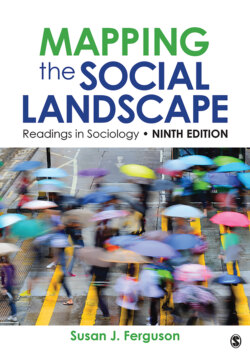Читать книгу Mapping the Social Landscape - Группа авторов - Страница 41
На сайте Литреса книга снята с продажи.
Interpreting the Answers to Empirical Questions
ОглавлениеSometimes the answer to an empirical question can create a great deal of interpretive trouble. For example, to ask “What are the rates of poverty among blacks and whites living in the United States?” is to ask an empirical question. We can look up the answers because someone else (the U.S. Census Bureau) has already done the counting and the arithmetic. As I noted earlier, the poverty rate among blacks is about 30 percent and among whites it is about 15 percent (these figures fluctuate somewhat and can also vary depending on how poverty is defined). But what do these figures mean? How can we interpret them?
I once presented these figures during a discussion of racial inequality. The class suddenly got quiet. No one wanted to comment on the meaning of the percentages. When I pressed for some reaction, a white student said, “I think no one is talking because the figures are embarrassing.” Did he mean that the figures were embarrassing because they pointed out a failure to overcome racial inequality? I wasn’t sure, so I asked him to be more explicit. “The figures are embarrassing,” he said with some hesitation, “to black students.” I was baffled by this.
After further conversation, it became clear that the student who spoke about the figures being “embarrassing to black students” saw the figures as evidence of black inferiority. His presumption was that the poverty rate of a group was an indicator of the capability of people in that group. I saw the figures as evidence of racism and discrimination. In this case, the facts about poverty rates were clear, but they did not speak for themselves. The same facts lent themselves to nearly opposite interpretations.
To support my interpretation, I might have said that in the United States, millions of people, black and white, are poor because they can’t find jobs that pay a decent wage, or they can’t find jobs at all. Sometimes the jobs available in an area don’t match people’s skills. Or else the jobs disappear when employers move factories to foreign countries where they can pay workers less. And so people can end up poor, or very nearly poor, even though they are able and willing to work.
I might have added that the higher poverty rate among blacks is a result of factories being closed down in inner cities in the North, where a lot of the black population is concentrated. It’s a result of schools that do not serve black children well. It’s a result of discrimination in hiring and network advantages enjoyed by whites. In some cases, part of the problem is a lack of marketable skills, but that’s because access to education and training is limited, not because people’s natural abilities are limited.
I might have said all this—and probably did—but was it enough to establish my interpretation as correct? Although I am sure that my statement helped some people see why the white student’s interpretation was wrong, others who preferred to hold onto that interpretation could point out, correctly, that I had not really proven—by anything I’d said or any evidence I’d shown—that blacks were not inferior to whites. All I had done was to suggest that “black inferiority” was not a plausible explanation—if other things were taken into account, if those other things were true, and if no significant counterevidence was being overlooked.
My interpretation was not, however, a matter of opinion. My interpretation was based on previously answered empirical questions. Have jobs disappeared in areas heavily populated by blacks? Do employers discriminate against blacks? Do whites enjoy network advantages when it comes to getting jobs? Do schools serve black kids as well as they serve white kids? Is there a lack of access to education and job training? With knowledge of the answers to these empirical questions, we can determine which interpretation of the poverty-rate figures is most likely to be correct….
